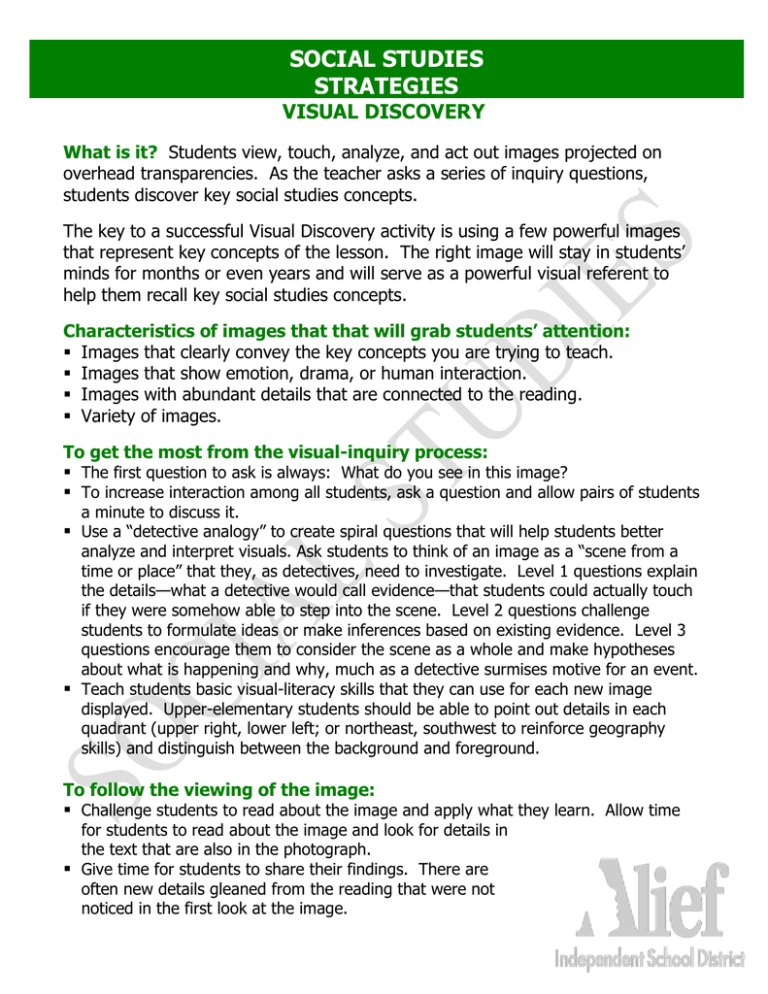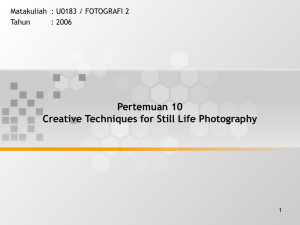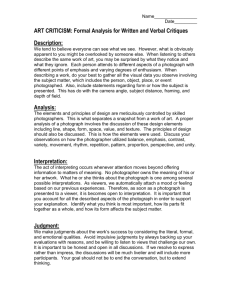Visual Discovery
advertisement

SOCIAL STUDIES STRATEGIES VISUAL DISCOVERY What is it? Students view, touch, analyze, and act out images projected on overhead transparencies. As the teacher asks a series of inquiry questions, students discover key social studies concepts. The key to a successful Visual Discovery activity is using a few powerful images that represent key concepts of the lesson. The right image will stay in students’ minds for months or even years and will serve as a powerful visual referent to help them recall key social studies concepts. Characteristics of images that that will grab students’ attention: Images that clearly convey the key concepts you are trying to teach. Images that show emotion, drama, or human interaction. Images with abundant details that are connected to the reading. Variety of images. To get the most from the visual-inquiry process: The first question to ask is always: What do you see in this image? To increase interaction among all students, ask a question and allow pairs of students a minute to discuss it. Use a “detective analogy” to create spiral questions that will help students better analyze and interpret visuals. Ask students to think of an image as a “scene from a time or place” that they, as detectives, need to investigate. Level 1 questions explain the details—what a detective would call evidence—that students could actually touch if they were somehow able to step into the scene. Level 2 questions challenge students to formulate ideas or make inferences based on existing evidence. Level 3 questions encourage them to consider the scene as a whole and make hypotheses about what is happening and why, much as a detective surmises motive for an event. Teach students basic visual-literacy skills that they can use for each new image displayed. Upper-elementary students should be able to point out details in each quadrant (upper right, lower left; or northeast, southwest to reinforce geography skills) and distinguish between the background and foreground. To follow the viewing of the image: Challenge students to read about the image and apply what they learn. Allow time for students to read about the image and look for details in the text that are also in the photograph. Give time for students to share their findings. There are often new details gleaned from the reading that were not noticed in the first look at the image. Visual Discovery Note Taking Sheet Details/Evidence Inferences Hypothesis About Scene Fact Finding Sheet for Visual Discovery Directions: Find at least 10 details in the text that are also in the picture. Put a * by any new details you discovered after reading. 1. 2. 3. 4. 5. 6. 7. 8. 9. 10. Photo Analysis Worksheet Study the photograph for 2-3 minutes. Form an overall impression of the photograph and then examine individual items. Next, divide the photograph into quadrants and study each section to see what new details become visible. STEP 2 Inference STEP 1 Observation Use the chart below to list people, objects, and activities in the photograph. People Objects Activities Based on what you have observed above, list three things you might infer from this photograph. ___________________________________________________________ ___________________________________________________________ ___________________________________________________________ STEP 3 Questions What questions does this photograph raise in your mind? ___________________________________________________________ ___________________________________________________________ Where would you find answers to them? __________________________________________________________




